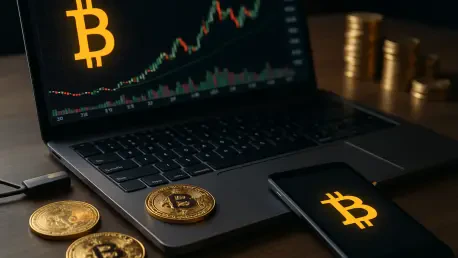The collapse of FTX, once a titan in the cryptocurrency exchange world, continues to send shockwaves through both legal and financial landscapes nearly three years after its dramatic downfall, marking a defining moment for the crypto industry. This saga, characterized by staggering financial losses and high-profile legal battles, exposes deep-rooted issues of oversight and trust. At the heart of the ongoing turmoil are the personal and systemic repercussions faced by key figures like Ryan Salame, former co-CEO of FTX Digital Markets, and his wife, Michelle Bond, whose legal entanglements highlight the intricate web of accountability. Simultaneously, efforts to repay creditors offer a glimmer of hope amidst persistent uncertainty. This unfolding narrative weaves together individual struggles with broader economic recovery attempts, painting a picture of an industry still grappling with the fallout of one of the most infamous scandals in its history.
Legal Turmoil Surrounding Salame and Bond
The legal proceedings involving Ryan Salame and Michelle Bond have become a focal point in the aftermath of the FTX collapse, shedding light on the personal toll of the scandal. Salame, who is currently serving a 7.5-year prison sentence for his role in the exchange’s failure, admitted last year to misusing FTX funds for illegal political campaign financing. What initially appeared to be a closed chapter with his plea deal has now resurfaced as a contentious issue in the case against Bond, a political candidate facing charges of conspiracy and illicit campaign funding. Her defense team argues that Salame’s mindset and motivations during his plea agreement are critical to understanding her involvement, seeking to use this as a mitigating factor. However, federal prosecutors have pushed back, insisting that Salame’s deal bears no relevance to Bond’s individual accountability. This clash in the courtroom underscores the complexity of assigning blame in a scandal of such magnitude, where personal and professional lines blur.
Beyond the specifics of their cases, the Salame-Bond legal battle serves as a microcosm of the broader challenges facing the justice system in addressing the FTX fallout. Each development in their proceedings reopens wounds for an industry already struggling to rebuild credibility. The dispute over the plea deal’s relevance raises questions about how far the ripple effects of individual actions can extend in corporate fraud cases. Prosecutors’ firm stance suggests a determination to hold each participant accountable separately, potentially setting a precedent for future crypto-related prosecutions. Meanwhile, the defense’s strategy highlights the nuanced interplay of personal relationships and legal responsibility, a dynamic that complicates the pursuit of justice. As these arguments unfold, they reflect a deeper tension between seeking closure for past wrongs and ensuring that all facets of the scandal are thoroughly examined, leaving the public and industry stakeholders watching closely for the outcome.
Financial Recovery Efforts for Creditors
On the financial front, the FTX Recovery Trust has been working diligently to address the economic devastation left in the wake of the collapse, with recent disbursements offering some relief to affected parties. A notable release of $1.6 billion earlier this year marked the third wave of reimbursements, bringing the total returned to creditors to $7.8 billion. For many with smaller claims, this has translated into recoveries exceeding 100% of their initial losses, a rare positive note in an otherwise bleak narrative. Yet, this influx of liquidity into the market introduces new concerns about its impact. Will these funds be reinvested into cryptocurrencies, withdrawn entirely, or contribute to volatility in an already fragile ecosystem? The answers remain unclear, but the scale of these repayments signals a significant step toward mitigating the economic damage caused by the exchange’s failure, even as full recovery remains elusive for some.
Despite the progress in creditor repayments, the broader implications for the cryptocurrency market cast a shadow over these efforts. The sudden availability of billions in recovered funds could either bolster confidence or exacerbate instability, depending on how recipients choose to act. Market analysts are keenly observing whether this capital will fuel a resurgence in crypto investments or trigger sell-offs that might depress prices further. Additionally, the uneven distribution of recoveries—where smaller claimants fare better than larger ones—raises questions about equity in the restitution process. This disparity could deepen distrust among those still awaiting full compensation, hindering the industry’s ability to turn the page. While the repayments represent a tangible effort to right past wrongs, they also underscore the delicate balance between economic recovery and maintaining market stability, a challenge that continues to define the post-FTX landscape for stakeholders across the board.
Lessons and Lingering Challenges
The enduring impact of the FTX collapse has cemented its place as a historic turning point for the cryptocurrency sector, exposing critical vulnerabilities in regulation and investor trust. The legal entanglements of figures like Salame and Bond serve as stark reminders of the personal accountability tied to corporate mismanagement, with each courtroom battle highlighting the depth of the fraud involved. Their cases illustrate how individual decisions can reverberate through an entire industry, leaving lasting scars on its reputation. Meanwhile, the financial restitution efforts, though substantial, reveal the complexities of rebuilding after such a catastrophic failure. The repayments provide hope to many but also expose the fragility of a market still reeling from the scandal’s aftershocks, where every step forward seems accompanied by new uncertainties.
Reflecting on these events, the path ahead for the crypto industry demands more than just financial settlements; it requires a fundamental reevaluation of safeguards and oversight mechanisms. Regulators and industry leaders face the task of implementing stricter controls to prevent similar debacles, while also working to restore faith among investors wary of past betrayals. The dual narrative of legal accountability and economic recovery points to a critical need for transparency and reform. As the dust settles on these chapters, the focus shifts to crafting policies that can protect against future mismanagement, ensuring that the lessons from this saga are not forgotten. The journey toward rebuilding trust is seen as a long-term endeavor, one that necessitates collaboration across sectors to address both the tangible losses and the intangible damage inflicted by the collapse.









